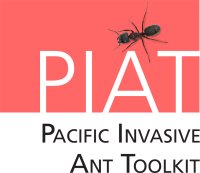Invasive ant distributions
Many invasive ant species are widely distributed around the Pacific and the world. It is important, for example when planning a risk analysis, to know which invasive ant species are present in neighbouring countries and trading partners, as well as your own country.
|
To help you identify which countries have which invasive ants, we have put together a Pacific Invasive Ant Distribution database, in an excel spreadsheet (updated August 2019), which you can download and browse. This database provides information on the global distribution of the 18 most problematic invasive ants species in the Pacific. You can find out what other ant species may be in your area by looking on our Ants of the Pacific database (updated November 2017). Fifteen of these species are classified as high or medium threats to the Pacific according to the PIAkey. Of the additional three species we have included in the database, Lepisiota frauenfeldi (browsing ant) and Nylanderia fulva (tawny crazy ant) are emerging threats. |

Global distribution of the yellow crazy ant (© AntWeb) |
Although Monomorium floricola (bicoloured trailing ant) is listed as a low threat in the PIAkey, it can be problematic when it nests in appliances such as laptops, and is strongly attracted to food left out in the open.
You can find out more about what makes the Pacific Invasive Ant Distribution database unique in our Pacific Conservation Biology publication (http://www.publish.csiro.au/PC/PC17004).
Information Sources for the Pacific Invasive Ant Distribution database
